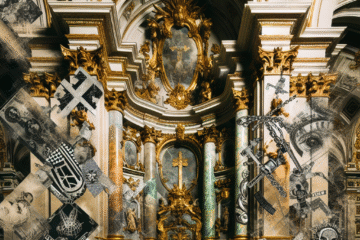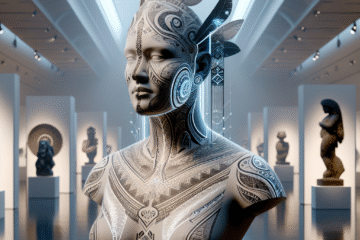I. Introduction
A. Definition of Digital Art
Digital art refers to a form of art created through the use of digital technology. This technology can range from computer programs and software to online platforms and digital tools. The term “digital art” encompasses a variety of mediums, including 2D and 3D graphics, animations, digital paintings, and even video game design.
B. Brief History of Digital Art
The history of digital art dates back to the 1950s, when the first computers were being developed. However, it wasn’t until the 1970s and 1980s that digital art began to gain recognition as a legitimate art form. With the advent of the personal computer, artists were able to create digital works in a more accessible and affordable way. In the 1990s, the Internet began to play a major role in the dissemination of digital art, making it possible for artists to share their works with a wider audience.
C. Purpose of the Article
The purpose of this article is to explore the impact of technology on the evolution of digital art. We will examine the ways in which technology has influenced the creation and consumption of digital art, as well as the ways in which it has changed the art world as a whole. Additionally, we will look to the future to consider the role technology will continue to play in shaping the future of digital art.
Overall, the article aims to provide an in-depth look at the relationship between technology and digital art, highlighting the ways in which the two have evolved together over the years, and exploring the ways in which they will continue to shape each other in the future.
II. The Emergence of Technology in Art
A. The Introduction of Computer Technology
The introduction of computer technology marked a major turning point in the history of art. Prior to the development of computers, artists were limited to traditional mediums such as paint, charcoal, and pencil. With the advent of computer technology, artists were suddenly able to create digital works in a way that was previously impossible. This new form of art was initially met with skepticism by some in the art world, but it quickly gained recognition as a legitimate form of artistic expression.
B. The Advent of the Internet
The advent of the internet further expanded the reach of digital art. With the ability to share works online, artists were able to connect with a wider audience than ever before. The internet also made it possible for artists to collaborate on digital works from remote locations, which was previously impossible with traditional mediums. This newfound ability to collaborate and connect with others led to an explosion in the creation of digital art, with artists from all over the world contributing to the genre.
C. Impact of Technology on Traditional Art Forms
The impact of technology on traditional art forms has been profound. In many cases, traditional mediums such as painting and drawing have been transformed by the introduction of digital technology. For example, digital painting and drawing software has made it possible for artists to create highly realistic works that would have been difficult or impossible to achieve with traditional mediums. Additionally, the ability to manipulate digital images has given artists new tools to experiment with, allowing them to create works that would have been impossible with traditional mediums.
At the same time, technology has also had an impact on the way traditional art forms are consumed. For example, digital tools have made it possible to view works of art online, making it easier for people to access and appreciate art from all over the world. This has led to a democratization of the art world, with more people having access to works of art than ever before.
Overall, the impact of technology on traditional art forms has been significant, with technology transforming the way art is created and consumed. While traditional mediums remain an important part of the art world, digital technology has opened up new avenues for artistic expression and has made it possible for artists to reach a wider audience than ever before.
III. The Evolution of Digital Art
A. Development of New Mediums for Digital Art
As technology has advanced, so too has the range of mediums available for digital art. In the early days of digital art, most works were created using simple 2D graphics programs. However, with the advent of more advanced computer hardware and software, artists have been able to develop new mediums for digital art, including 3D graphics, virtual reality, and even video game design. These new mediums have opened up new avenues for artistic expression, allowing artists to create works that are more complex, immersive, and interactive than ever before.
B. Advancements in Graphics Software
The advancements in graphics software have also had a major impact on the evolution of digital art. With each new release, graphics software has become more powerful and easier to use, making it possible for artists to create increasingly complex and sophisticated works. For example, the introduction of 3D graphics software has made it possible for artists to create highly detailed and realistic 3D models, which can be used for a variety of purposes, including animation, gaming, and even product design.
C. The Rise of New Forms of Digital Art
As technology has advanced, so too have the forms of digital art that are being created. In addition to the traditional forms of digital art, such as digital paintings and drawings, new forms of digital art have emerged, including digital sculptures, virtual reality experiences, and even artificial intelligence-generated art. These new forms of digital art have pushed the boundaries of what is possible in the world of digital art, and they continue to be an important part of the digital art landscape.
Overall, the evolution of digital art has been marked by a series of technological advancements that have transformed the way digital art is created and consumed. From the introduction of computer technology and the advent of the internet, to the development of new mediums and the rise of new forms of digital art, technology has played a critical role in shaping the evolution of digital art over the past several decades.
IV. Impact of Technology on the Art World
A. Expansion of the Audience for Digital Art
The impact of technology on the art world has been significant, particularly in terms of the expansion of the audience for digital art. With the advent of the internet, digital art has become more accessible to people all over the world, allowing artists to reach a wider audience than ever before. Additionally, the ability to view works of art online has made it easier for people to access and appreciate digital art from all over the world. This has led to a democratization of the art world, with more people having access to works of art than ever before.
B. Increased Accessibility to Digital Art Tools and Resources
The impact of technology on the art world has also been felt in terms of the increased accessibility to digital art tools and resources. With the widespread availability of affordable computer hardware and software, artists now have the tools they need to create digital art at their fingertips. Additionally, the internet has made it possible for artists to access a wealth of information and resources that can help them improve their skills and learn new techniques.
C. Changes in the Way Digital Art is Created, Shared, and Consumed
Finally, technology has had a significant impact on the way digital art is created, shared, and consumed. With the ability to share works online, artists are now able to connect with a wider audience than ever before. Additionally, the rise of new forms of digital art, such as virtual reality experiences, has transformed the way digital art is consumed, making it more immersive and interactive than ever before.
Overall, the impact of technology on the art world has been profound, with technology transforming the way digital art is created, shared, and consumed. From the expansion of the audience for digital art to the increased accessibility of digital art tools and resources, technology has played a critical role in shaping the future of the art world.
V. The Future of Digital Art
A. Emerging Trends in Digital Art
As technology continues to evolve, so too will digital art. Emerging trends in digital art include the increasing use of virtual and augmented reality, the rise of artificial intelligence-generated art, and the development of new mediums for digital art, such as holographic displays. These emerging trends suggest that the future of digital art will be defined by increased immersion and interactivity, as well as the use of cutting-edge technologies to create new and exciting forms of artistic expression.
B. Predictions for the Continued Evolution of Digital Art
As technology continues to advance, it is likely that digital art will continue to evolve in new and exciting ways. Some predictions for the future of digital art include the increased use of virtual and augmented reality, the development of new forms of digital art, and the rise of new mediums for digital art. Additionally, it is likely that digital art will become even more accessible and democratic, allowing artists to reach a wider audience and allowing more people to access and appreciate works of digital art from all over the world.
C. The Role of Technology in Shaping the Future of Digital Art
Technology will continue to play a critical role in shaping the future of digital art. As technology advances, it will open up new avenues for artistic expression, allowing artists to create works that are more immersive, interactive, and sophisticated than ever before. Additionally, technology will continue to make digital art more accessible, democratizing the art world and allowing more people to experience and appreciate works of digital art from all over the world.
Overall, the future of digital art looks bright, with technology playing a critical role in shaping its continued evolution. From the rise of new forms of digital art to the increasing use of virtual and augmented reality, the future of digital art is sure to be defined by innovation, creativity, and the use of cutting-edge technologies.
VI. Conclusion
A. Summary of the Impact of Technology on the Evolution of Digital Art
The impact of technology on the evolution of digital art has been immense. From the introduction of computer technology to the widespread availability of affordable digital art tools and resources, technology has transformed the way digital art is created, shared, and consumed. The expansion of the audience for digital art, the rise of new forms of digital art, and the democratization of the art world are just a few of the ways in which technology has had a profound impact on the evolution of digital art.
B. Reflection on the Future of Digital Art
Looking ahead, the future of digital art is bright, with technology continuing to play a critical role in shaping its evolution. Emerging trends in digital art, such as the increasing use of virtual and augmented reality, suggest that the future of digital art will be defined by increased immersion and interactivity. Additionally, the rise of new forms of digital art, such as artificial intelligence-generated works, suggests that digital art will continue to evolve and change in new and exciting ways.
C. Final Thoughts on the Role of Technology in the World of Art
In conclusion, technology has played a critical role in shaping the world of art, and it will continue to do so in the future. From the democratization of the art world to the rise of new forms of digital art, technology has transformed the way art is created, shared, and consumed. As technology continues to advance, it will open up new avenues for artistic expression and allow artists to push the boundaries of what is possible in the world of digital art. Ultimately, the role of technology in the world of art is sure to be one of innovation, creativity, and the pursuit of new forms of artistic expression.


